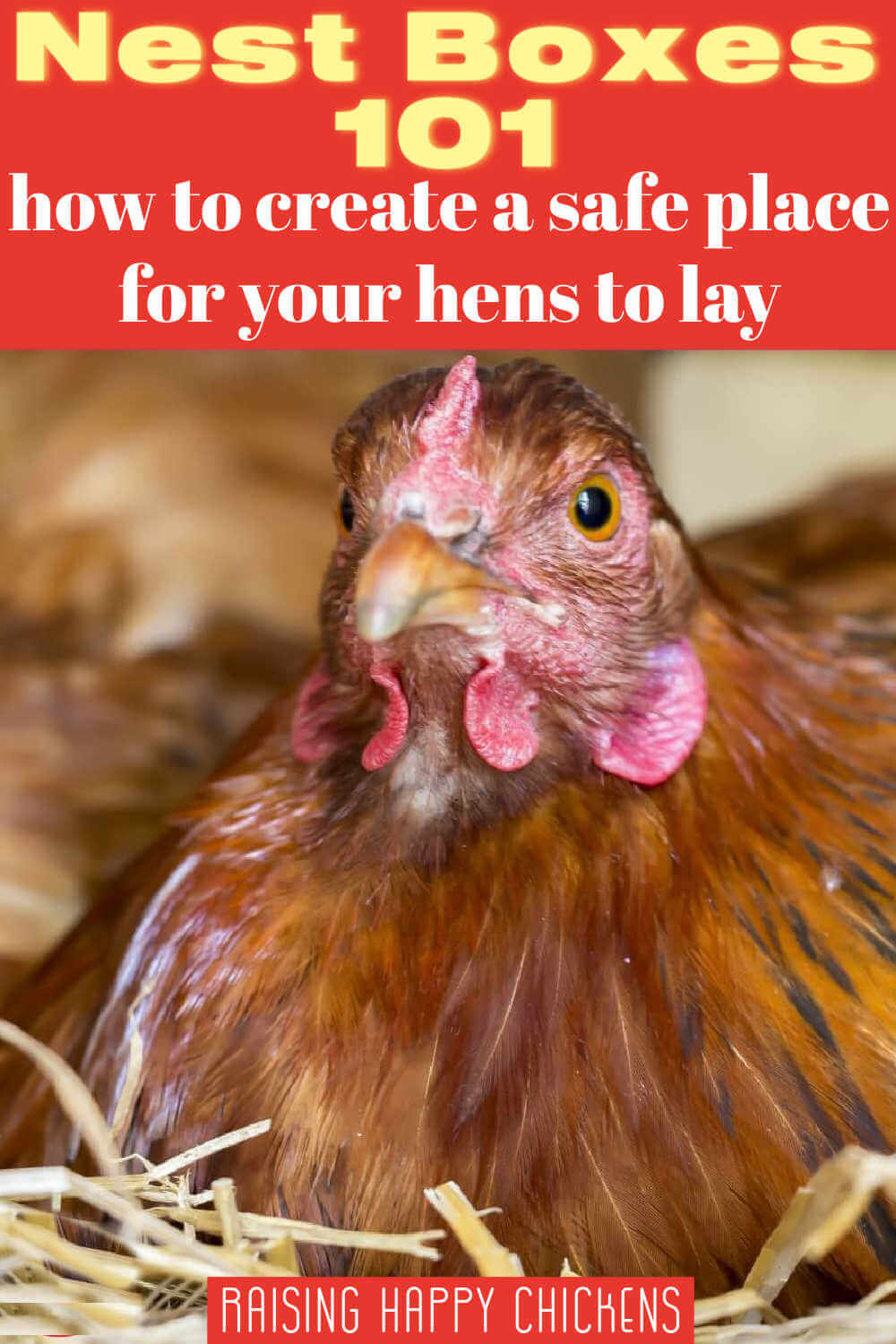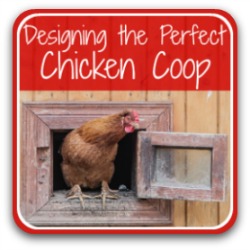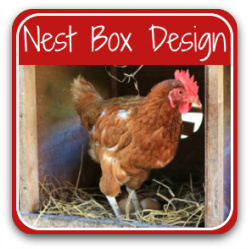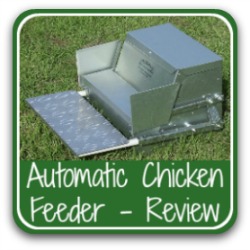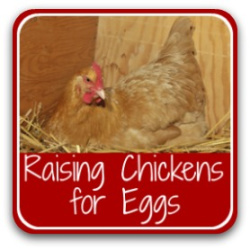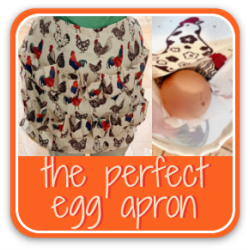Chicken nest boxes: creating a safe place for your hens to lay eggs.
Hens will lay wherever they feel most secure. So how do we make sure the nest boxes we want them to use meet their own health and safety standards?
If you're looking for more specific information about which type of nest box will best suit your situation, including information about which features to look for, which materials work best, and DIY information to create different designs including the popular "roll out" or "roll away" boxes, you need this article.
Have you noticed that hens will lay more or less anywhere apart from the beautiful nest boxes we provide?
Perhaps you've wondered where all the eggs are going, only to find them under a tree, or hidden in a pile of grass, or even under your car.
That's because they really don't feel the need to have a nest "box". Like most birds, they will find a place to lay wherever they feel safest.
What we want them to do, or what we think they need, is irrelevant to them.
So our task is to look at what that safe place might look like, and recreate it for them in the coop.
Unless you want to carry on hunting under the rose bushes for those missing eggs...
Looking for something specific about nest boxes?
Use these links to jump to wherever you want to go – or continue reading so you don't miss out on critical information!
What are ideal conditions for a hen's nesting box?
Chickens are an intuitive bunch. In the wild, they'll lay their eggs in a place where they are as protected as possible. Those eggs are, after all, potentially the next generation. A hen believes she's laying eggs which she may later choose to incubate and hatch.
So she'll always look for a place that's safe: quiet, private, dark and away from any perceived danger.
Our job is to make the place where our hens lay as close to that feeling of security as possible. The security aspect is always more critical than what kind of nesting boxes you use.
And if you don't get it right, your hens are likely to start laying elsewhere.
A short video of how a hen lets you know when she wants privacy!
How to make a hen feel secure when she lays.
- Quiet: make sure the nesting area is not near areas where there's a lot of movement: roosts, feeders, pop doors should all be in a different part of the coop.
- Safe: no other animals should be able to get into the nesting area. Check regularly for rats and mice, make sure the area is free from potential predators, and keep cats and dogs away.
- Private: laying hens don't like to be overlooked. Keep children and visitors away from the area in the mornings, when the hens are most likely to lay.
- Dimly lit: place the nesting boxes out of direct sunlight, in as dark a part of the coop as you can find. Research has shown that limiting light in the nesting area reduces the risk of feather-pecking(1).
- Raised off the ground, but accessible: hens know they're vulnerable when at ground level, so they'll try to find a raised spot to lay eggs. But heavier breeds can't fly well, so don't place the boxes too high. Somewhere between 18" and 2 feet is ideal.
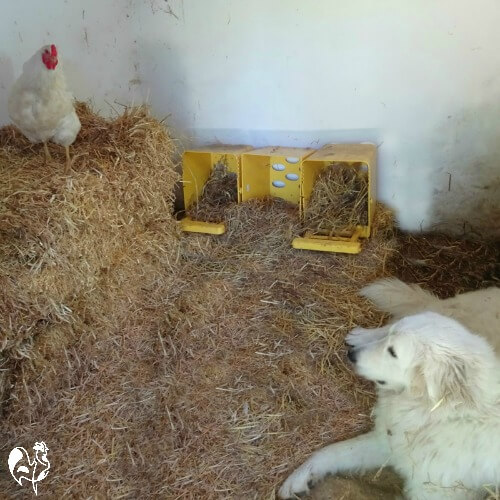 Lucinda Wyandotte refuses to lay while Luce, my Livestock Guardian Dog, looks on.
Lucinda Wyandotte refuses to lay while Luce, my Livestock Guardian Dog, looks on.What are ideal laying conditions for you?
If you're planning your chicken coop, or considering buying or making some new nest boxes, think about what would make the ideal position for your personal situation.
- You'll need easy access for collection. If you have children who want to help make sure it's low enough for them to reach, too.
- You'll also need to be able to access the next boxes for cleaning. Keeping them free from dirt isn't just about having your eggs in the best possible condition, it's also about keeping rodents and flies away from the coop.
- Do you have a hen who eats eggs? It can be a real problem. In that case, you may want to think about nest boxes that have a "roll-away" for the eggs. After the hen lays, the egg literally rolls down the box to an area no-one but you can access.
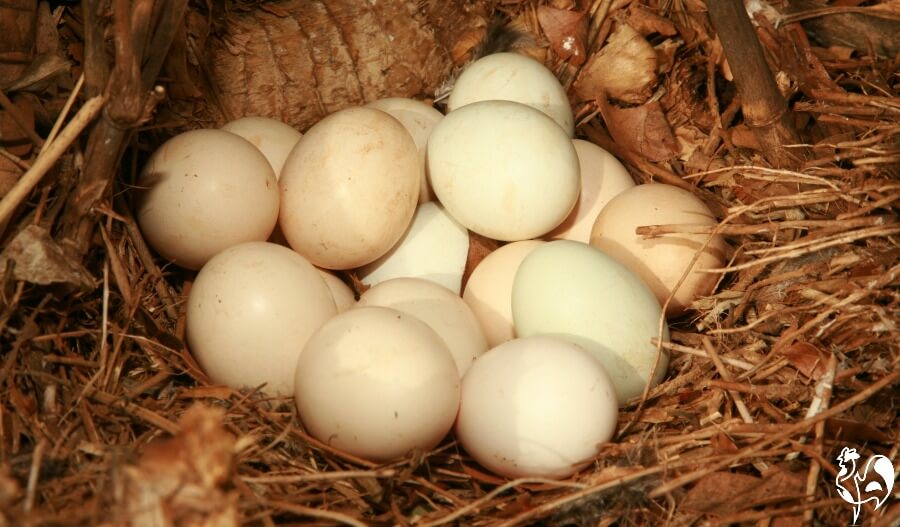 Not providing the right conditions will lead to eggs being laid anywhere but where you want them.
Not providing the right conditions will lead to eggs being laid anywhere but where you want them.Do your chickens need curtains?
It's true that hens like an isolated spot to lay, and you'll find quite a lot of information on the web about making your next boxes more private by hanging curtains.
I admit, when I first had chickens I loved this idea of privacy for my hens, and bought chicken-themed material to make them.
Then I discovered that hens create quite a lot of dust. I was also concerned about the possibility of curtains harbouring mites, which tend to cling onto any surface that's not shiny.
I was forever washing the curtains and, in the end, I took them down. Too much work - simple is best, as far as I'm concerned.
But this is a matter of personal preference.
If you have somewhere to place nest boxes which is quiet and relatively dark, you probably don't need curtains. If you haven't, and you like to pretty-fy your coop, that's fine.
Do just bear in mind the cleanliness aspect, though.
How big should nest boxes be?
One of the "Five Freedoms" for chickens lays down that they must be able to express "normal behaviour" by having access to enough space.
"Normal behaviour" includes nesting to lay, and enough space means that your hens need to be able to sit, stand and turn round easily in their nest box(1).
So the size will in part depend on the breed of chicken. Hybrids such as the Red Star and traditional large breeds like the Wyandotte or Livorno (Leghorn) need a box at least 12" (30cm) tall x 12" wide and 12" deep.
Larger breeds like the Brahma and even "fluffier" breeds such as the Orpington will need more space; bantams will require less.
How many hens should there be per nest box?
In some ways it really doesn't matter, because what you'll find is there's a "favourite" box that everyone queues up to get.
No matter how many nest boxes they have available, nothing will persuade hens to use them if they decide there's a special one.
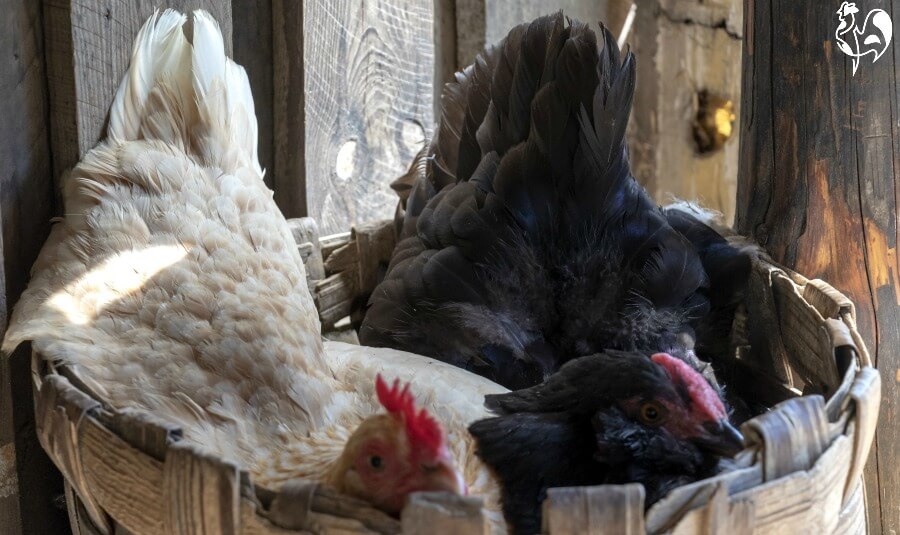 No matter how many nest boxes you have, chances are they'll all want the same one!
No matter how many nest boxes you have, chances are they'll all want the same one!There are official requirements for this, although they're really meant for commercial egg-laying businesses where hens were (and in some places still are) crammed into tiny cages with little or no room to move.
For backyard chickens, the ratio should be at least one nest box for five hens to be accepted as "humane conditions"(2).
I prefer a ratio of one box to three hens. That allows for plenty of choice – although there's often still a queue for the favourite!
What is the best bedding for nesting boxes?
Bedding serves two purposes: to provide a clean place for hens to lay, and a safe place for eggs to fall.
Broken eggs are all too easy for hens to eat, and getting a taste for them can lead to serious egg-pecking, which is very hard to stop.
In Europe, EU regulations for the welfare of chickens state that chickens must not have to sit on wire, or plastic-coated wire(2). Most backyard chicken keepers wouldn't dream of making their hens use this as a nest box, but it needs saying.
Looking at bedding which is both safe and easy to clean, then, here are some possibilities, starting with my preferred option.
Some links in the following sections are affiliate links, which means that if you purchase a product through them I receive a small commission. There is no extra cost to you. Find more details on this page.
Because my integrity and your satisfaction are very important to me, I
only recommend products I have purchased or would purchase myself and which I believe
would benefit you.
What to put in a nesting box: my preferred option.
Nest liners: Made from wood shavings on a paper backing, these pads slot into most nest boxes easily. They're thick enough for the hens to "fluff up" which they like to do before settling, and they can be cleaned by simply shaking dirt off them. They don't contain chemicals and they're biodegradable, so can be composted after use.
I add some dried lavender to them. I grow my own, so it's cheap!
I'd not heard of these nesting pads until quite recently. Now I wouldn't use anything else. I find they work particularly well in my Eglu Cube chicken coop.
Other options for nest box bedding.
Straw: this is the bedding most people choose to use, including me before I discovered the liners. It's affordable, soft enough for eggs not to break and it looks nice! On the downside, it's not very absorbent, so poop can make it wet and wetness makes it go mouldy. And it can harbour mites.
The answer? Make sure you clean the nest boxes regularly. Get rid of any poop immediately, and check your coop for mites at night.
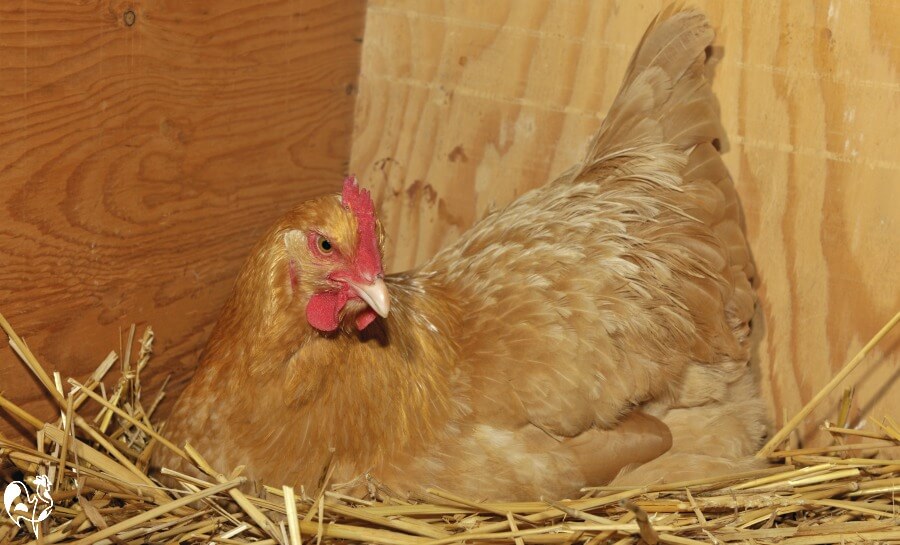 A straw bedding in the nest box is safe - as long as it's kept clean.
A straw bedding in the nest box is safe - as long as it's kept clean.Sand: becoming increasingly popular as bedding in the coop, it's a good option in that it's easy to clean, but be careful to get the right type. Play sand is too fine and can cause respiratory problems, so go for construction sand which is heavier.
Personally I don't use sand in nest boxes, although I do use it in the coop. It can become compacted and I'm concerned that eggs may break.
Wood shavings: always get the larger chips, not the smaller shavings and certainly not sawdust, which can cause massive respiratory problems.
The wood must not be hard wood, particularly not cedar, as mould can be a problem and the oils are toxic for chickens. And beware (again) of mites and other bugs who love hiding in wood shavings.
Of all wood shavings, dust free pine is best.
Chopped cardboard: more absorbent than paper, dust free, doesn't get compacted like sand and can be composted. Doesn't look very pretty, and rodents quite like chewing it. Otherwise, this is a good option.
Leaves and other backyard waste: I use dried leaves very successfully as bedding in the coop: the hens love scratching round in them looking for bugs. But I don't use them in the nest boxes for exactly that reason – the hens tend to scratch them all over the place. Within a day I found the nest boxes were empty.
Don't use grass clippings – they're too full of moisture – and be careful not to use anything that's been treated with chemicals.
If you have nest boxes with a lip, and leaves that haven't been sprayed and have dried out, this might work well. Otherwise, use something else.
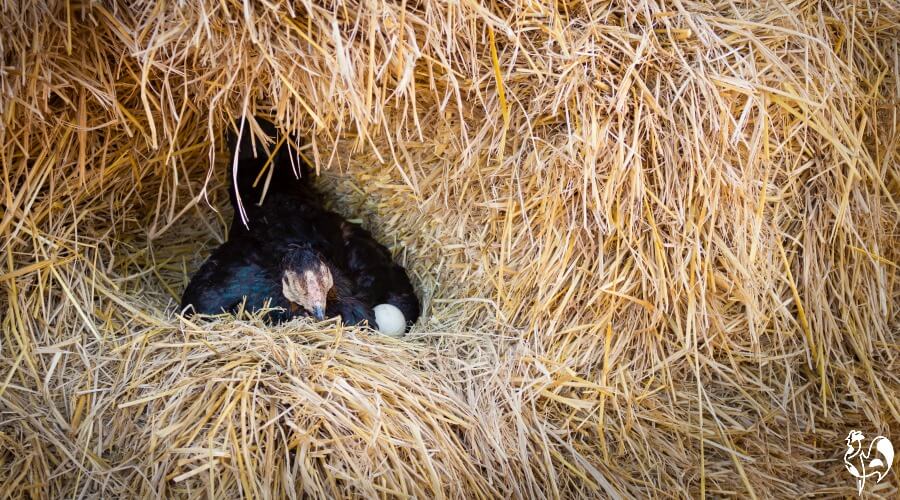 A cosy place to raise a family!
A cosy place to raise a family!Is it ok for hens to sleep in their nest boxes?
No. This is a cleanliness issue.
Chickens poop. A lot. Sleeping in the nest box means they'll deposit poop there. Poop attracts flies. You do not want flies – or poop – on your lovely fresh eggs. Or, even worse, laying their eggs on your hens.
Don't allow your flock to sleep in nest boxes. Fix up a proper roost for them and think about making or buying nest boxes with a sloping roof or with perches that hinge upwards to block entry at night.
When should you clean nest boxes out?
Hens are very house-proud. They like to lay where it's clean, and if their nest boxes become dirty they may well find somewhere else to lay.
Leaving eggs in nest boxes for too long will also attract rats, who love eggs.
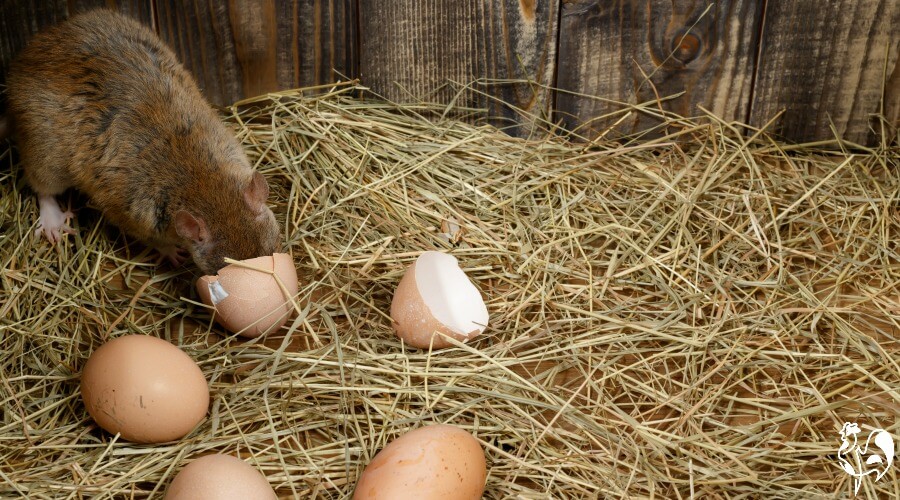 Leaving eggs in nest boxes for too long will attract rats.
Leaving eggs in nest boxes for too long will attract rats.So check your nests every day when you collect eggs, and collect eggs at least once a day, more often for a larger flock.
- To make sure your eggs don't break, invest in something like my egg collecting apron.
Make sure the bedding is clean and remove any containing poop. Change it completely at least once a month.
Check for lice and mites, although you're unlikely to see mites during the day. Be aware too of issues around putting fresh flowers or herbs into nest boxes. See the next section for more information.
Do herbs in nest boxes help chickens lay?
There's no evidence of this at all – but there's no harm in using herbs in nest boxes, either. They smell wonderful, if you grow your own they're inexpensive and who knows, maybe chickens do get the same benefits from them as humans do!
 Rosemary, mint and lavender: easy to grow, but dry before you use them in nest boxes.
Rosemary, mint and lavender: easy to grow, but dry before you use them in nest boxes.A warning, though: if you're planning to use fresh herbs, make sure you have time to clean out the nest boxes very regularly.
Why? Because fresh herbs can rot and create bacteria in the bedding. So if you're not sure you have the time, use dried herbs instead.
Which herbs to try? It's fun to make up your own pot-pourri, but my favourite of all time is lavender. It's easy to grow and dry, is known to have a calming effect (yes, even on chickens!) and smells amazing.
If you don't want to grow your own, or you have no space, these lavender buds are good value and last for ages. Sprinkle a handful into the nesting box once a week.
Lemongrass is another favourite. It contains citronella which keeps flies and mosquitoes at bay, and the chickens love to eat it.
And finally, mint is another easily grown herb which smells delicious, is said to have a calming effect and is fine for your hens to eat, if they feel like.
You may come across information on the web that mint will repel rodents. There's no evidence of this at all - rats are attracted by the smell of grain, not repelled by herbs.
If you like the idea, but don't want to grow herbs...
It's possible to buy prepared herbs for coops. I prepare my own, so I haven't used this one, but it's particularly highly recommended by customers as being sweet-smelling and retaining the smell for a long time.
How to get your hens to lay in nest boxes (as opposed to wherever they feel like!).
Making your nest boxes as close as possible to what chickens would use in the wild will give the best possible chance of them laying where you want them to lay. So following the tips in this article should help.
New hens you introduce to an existing flock of layers will get the idea very quickly: they'll do what their elders do.
But some may refuse to use your safe, dark, private nest boxes, no matter what you do. If that's the case take a step back and try to look at your nest boxes from a hen's perspective. Is it too noisy? Not private enough? Too light? Too small?
Put those things right and try again. If none of that works, here are some final tips you can try.
- Place one fake "nest egg" in each box. Some people use golf balls, but I've found a wooden or ceramic egg works best. This trick generally works - occasionally a hen will even go broody and try to sit on a fake egg!
- These wooden eggs are particularly good for your kids to play tricks on their friends - I've seen the shock on their faces as they expect the eggs to splat all over the floor!
- Ceramic eggs can double up as a deterrent if you have hens who peck their eggs, or rodents whose main aim in life is to eat all the eggs before you have a chance to collect them.
- Make the place where they've been laying as uncomfortable as possible. Block up the entrance, lay bricks under the tree, cut away undergrowth so the light shines in.
- If all else fails, keep the hens locked in the coop during the morning until they've laid. This doesn't necessarily mean they'll lay in the boxes, of course.
- If they still lay outside the nest boxes, for example on the floor, take up all bedding except for what's in the nest boxes.
And finally...
If you discover one of your hens isn't laying where she should and she disappears from the flock altogether, don't assume the worst.
It's not unusual for a hen to gather a clutch of eggs somewhere she feels is safe, only to return to the flock three weeks later – with babies in tow!
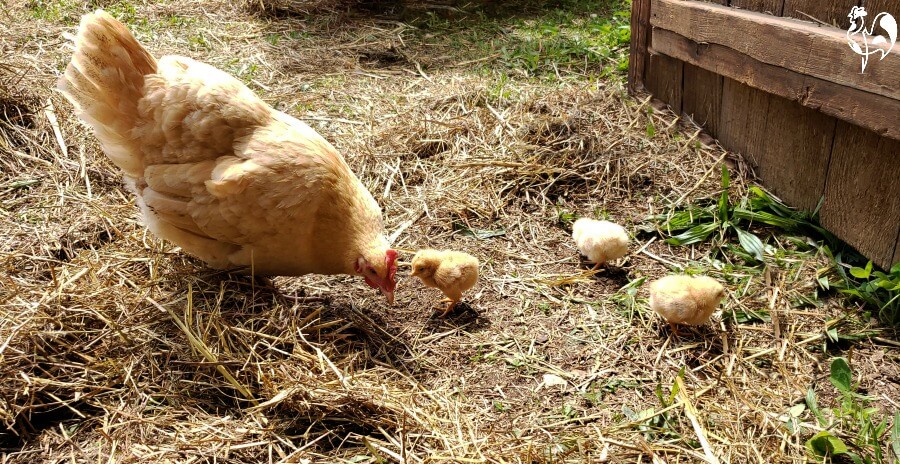 The wanderer returns!
The wanderer returns!Where would you like to go now?
Sources.
A lot of "facts" you'll find on the internet are often people's individual views, based on inaccurate information repeated from poor quality sources.
The information I provide in this article and others is based not just on my own experience, but on evidenced facts from scientific, peer-reviewed research and books from highly respected and experienced poultry keepers such as Gail Damerow.
Some of the trusted sources I have used in this article are these.
1. RSPCA: Welfare standards for laying hens. Pub. Royal Society for the Prevention of Cruelty to Animals, 2017.
2. European Union: Higher welfare systems for laying hens. Pub. EU Commission, via Compassion in World Farming, 2018.
3. DEFRA (UK): Code of practice for the welfare of laying hens and pullets. Pub. August 2018.
